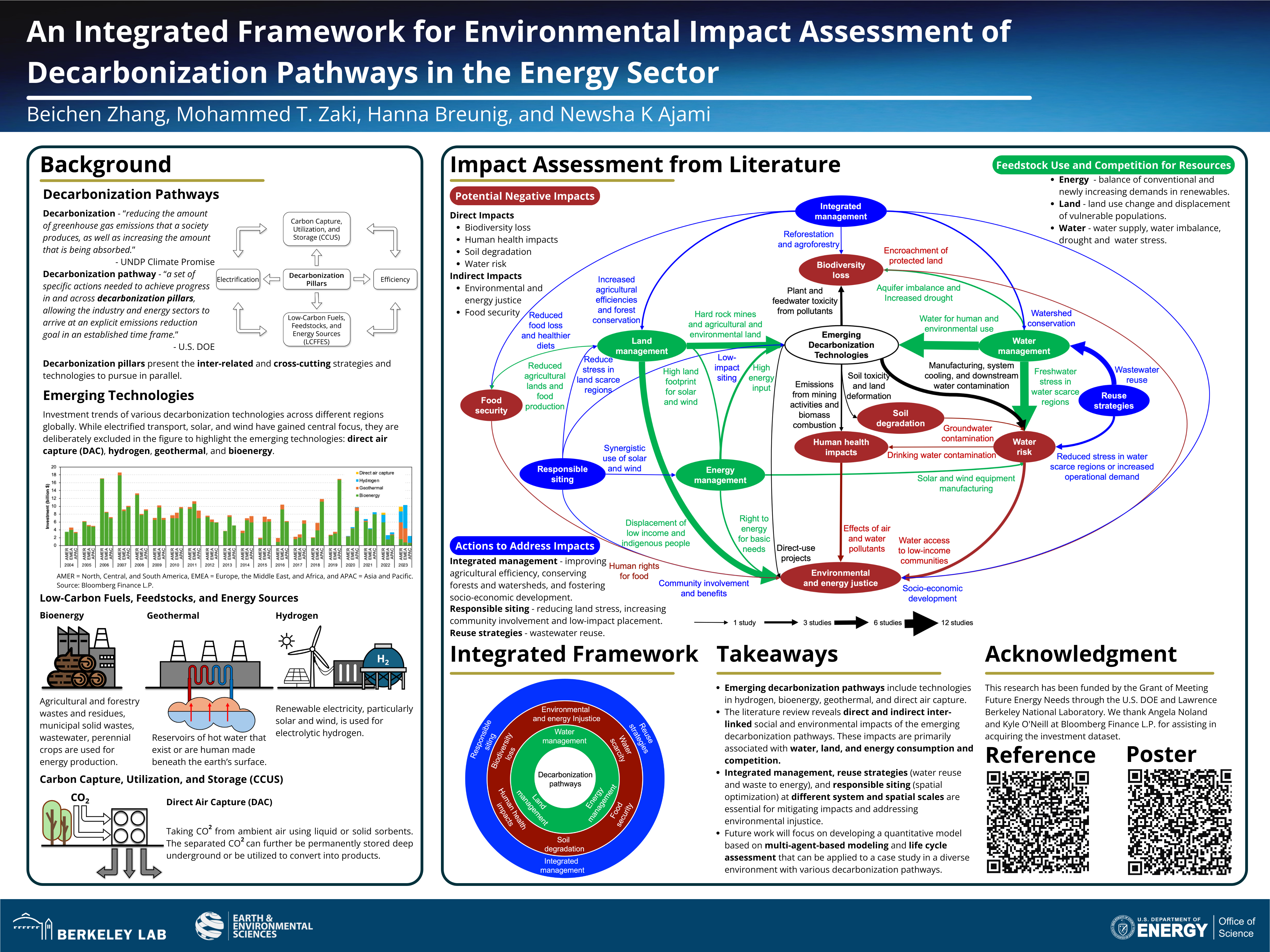AGU Fall Meeting 2024 is coming. This is the first professional and international conference attended after graduating and joining Berkeley Lab. I will present my postdoctoral work on developing a conceptual framework through literature review to evaluate inter-dependencies among energy transition & decarbonization pathways, natural resources, and environmental & social impacts. My colleague, Tamim, is the lead author of this task. In addition to assisting with its development, my primary role is to translate the conceptual framework into a quantitative model. Our poster presentation is from 8:30 am to 12:20 pm on December 11. Please stop by and chat with me!
Decarbonization pathways, which involve actions and technological deployments to reduce greenhouse gas (GHG) emissions in the energy sector, are crucial for mitigating climate change and its impacts. Key elements of these pathways include advancements in efficiency, electrification, low-carbon energy sources, and carbon capture and storage. Commonly used applied frameworks for quantifying environmental impacts, such as Life Cycle Assessment, are based on predefined rigid system boundaries and often only focus on individual decarbonization pathways. These characteristics in the conventional frameworks significantly limit their effectiveness in capturing social and environmental nuances and providing practical strategies for natural resource management and decision-making processes. In this study, we developed an integrated framework to assess societal and environmental impacts at dynamic spatial scales, aiming to capture the complex interactions of diverse decarbonization pathways to minimize adverse effects and maximize benefits at the system level. The novelty of the proposed framework lies in its comprehensive integration of qualitative and quantitative assessment techniques, multidimensional impacted sectors, and diverse decarbonization pathways. The framework was constructed from a systematic literature review focusing on the pathways, including hydrogen, geothermal energy, bioenergy with carbon capture and storage, direct air capture, and lithium mining, because of their promising applications and future opportunities. We also utilized textual descriptions and quantitative data from the Bloomberg New Energy Finance (BNEF) datasets to incorporate up-to-date insights to develop the framework. Through a case study in California, our framework was preliminarily applied to map the impacts in the context of water resource management, reducing the constraint of system boundaries and accounting for interactions among the focused pathways. This work showcases a robust decision-making and policymaking framework to design more sustainable and equitable decarbonization strategies, offering a complete view of the complex trade-offs between managing natural resources and reducing emissions.

Additionally, I will present a comprehensive version of my Ph.D. work on applying AI models to monitor and assess the impacts of drought. If you are interested, please feel free to come to the poster session on the afternoon of December 12.
NH43B-2398: Novel AI Applications for Drought Impact Monitoring and Assessment
Drought is a prevalent and consequential natural disaster, posing widespread challenges across environmental and societal dimensions. Despite the considerable focus on monitoring drought events and studying their hydrometeorological characteristics, there is a gap in assessing their impacts, especially on socioeconomic sectors. Due to the complex and indirect relationships between observed drought conditions and the affected objectives, capturing and analyzing multidimensional drought impacts through conventional datasets, such as remotely sensed imagery, is challenging and inadequate. This presentation showcases several interdisciplinary studies based on AI techniques, such as natural language processing and explainable machine learning, and multi-level textual datasets across news media, citizen scientists, and stakeholders in different spatial and temporal scales. The text-based data were focused on the United States and acquired from the Drought Impacts Toolkit at the National Drought Mitigation Center. The results of these studies demonstrate that diverse textual data coupled with advanced AI techniques can significantly contribute to monitoring and assessing multidimensional drought impacts. We suggest future research to focus on the local and community levels to further study the non-linear relationships between drought events and impacts with significant spatial and temporal variations. This work also highlights the need for efforts to study the attribution of effects to drought events, which could be quantified as causal relationships to better understand the complex pathways of drought impacts on socioeconomic sectors.

#AI #Energy Transition #Drought #Impact Assessment #Conference
